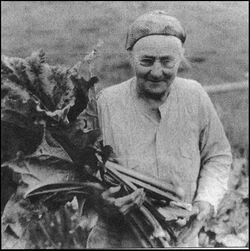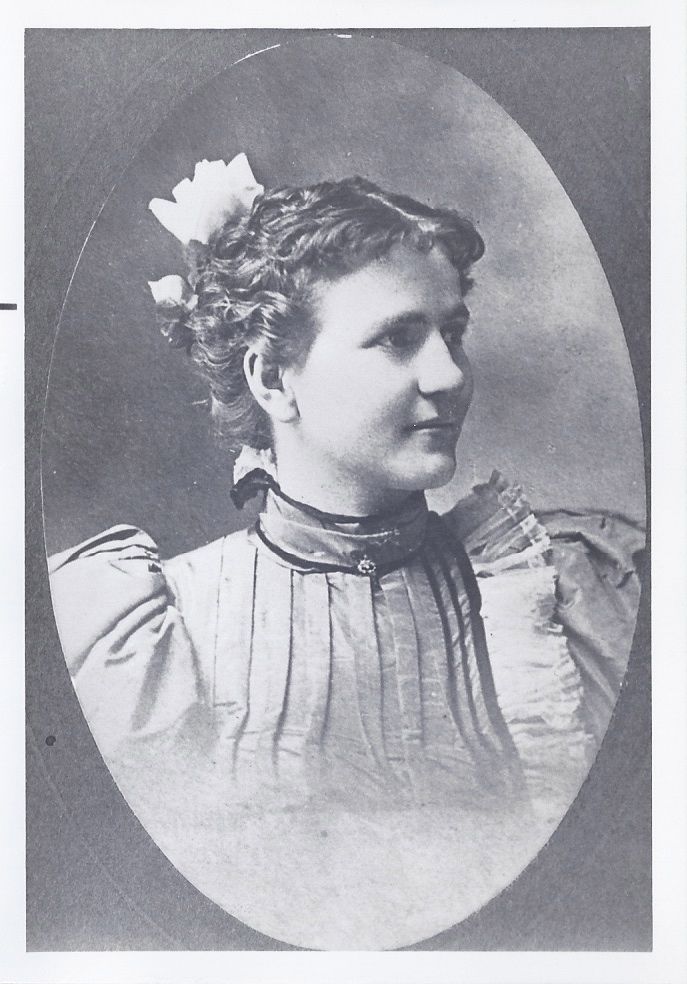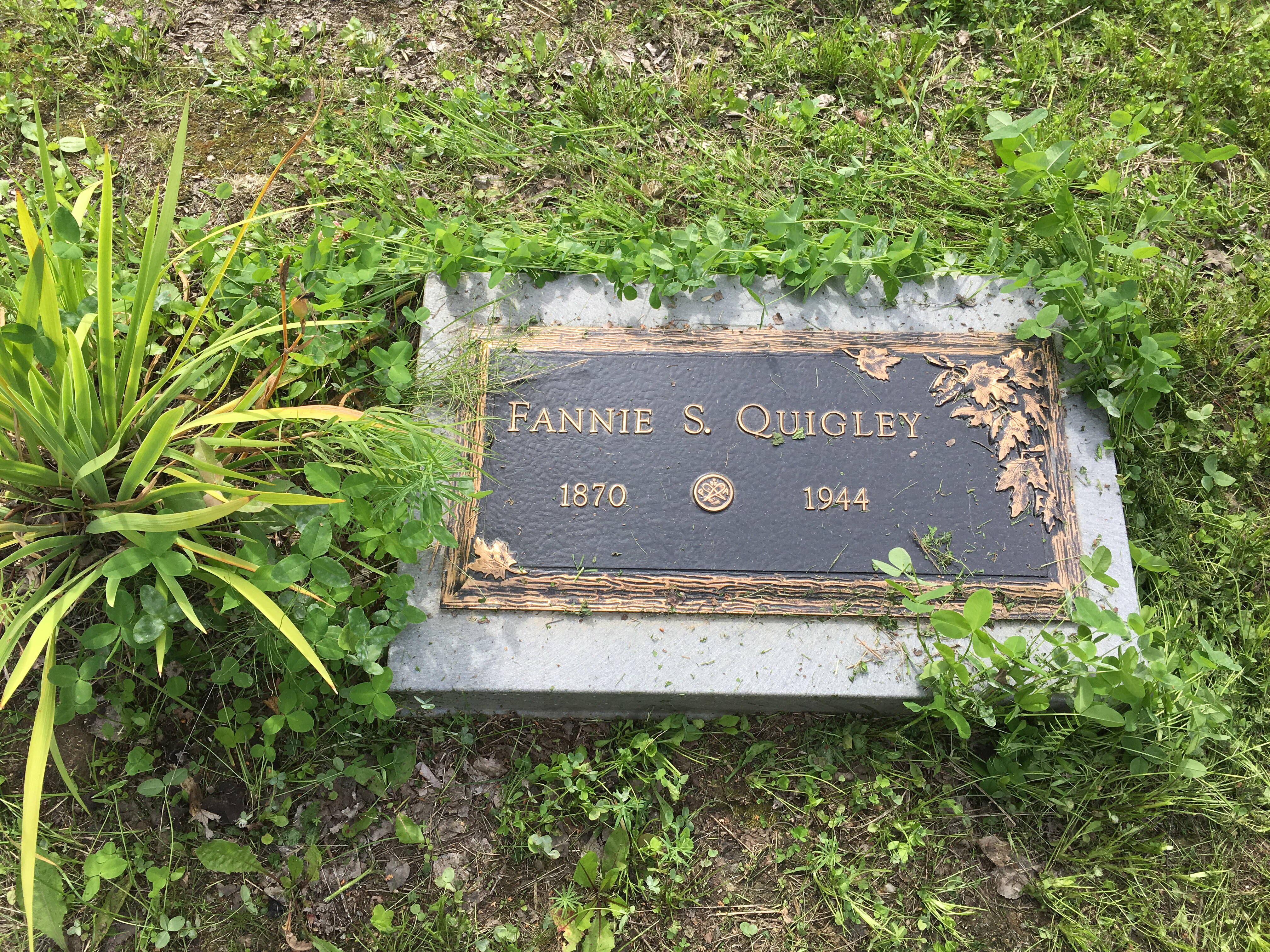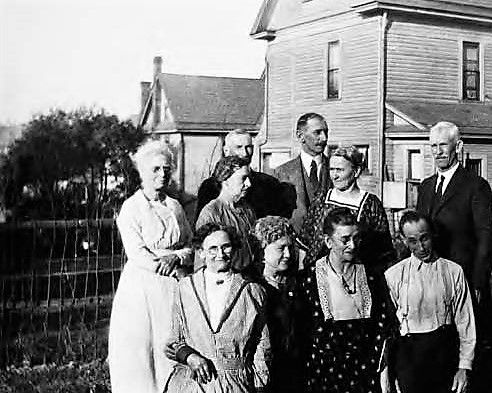Fannie Quigley is one of the mining pioneers who came to the land to find their fortunes. Fannie was a veteran of the Klondike and other stampedes. She had made her way to the remote Kantishna Hills among the hundreds of hopeful prospectors in 1905. Fannie arrived with a portable stove and food supplies and quickly opened for business to feed hungry stampeders. The gold, however, proved too sparse and the population of prospectors and miners in the district, along with the hastily constructed community of Eureka (now Kantishna), dwindled to about 50 hardy souls Fannie, however, stayed. She filed mining claims and built a life for herself. Fannie met Joe Quigley who was one of the first to pursue lode mining in the district and together they staked and mined their claims in the area. Fannie embraced this hardworking Kantishna lifestyle for nearly 40 years.
A Self Sufficient Lifestyle
Fannie used a dog team for transportation and freighting, as seen in the above photograph of her packing supplies to a mine in 1915. In addition to the mining activities that provided an income, there was the endless work to provide the basics of life in such a remote location. In Kantishna, everyday life included hauling water and cutting and hauling firewood. Both Fannie and Joe hunted moose, caribou, and Dall sheep for their meat and trapped marten and other animals in the winter to get furs to sell and wear. Fannie maintained large vegetable gardens and used nearby prospect tunnels for cold storage of produce and meat. They also pursued trapping during the winter as a way to generate some cash.
“Up and at’em” Fannie
When Grant Pearson (park ranger and former superintendent) first met Fannie Quigley in 1926, she was 55 years old and had been mining and living in the Kantishna Hills for 21 years. He described her as “up and at ‘em. She was a dog musher, prospector, trapper, hunter, woodcutter, gardener, and one of the best sourdough cooks I have ever run across. At a Christmas dinner once, Fannie served black bear roast, gravy, mashed potatoes, fresh cabbage, hot rolls, currant jelly,
cranberry sauce, and fresh blueberry shortcake. Only the flour and sugar had been freighted in. The rest was from the country.”
In 1930, Joe suffered a mining injury that effectively ended his mining career. Several years later, Joe and Fannie permanently parted, splitting their income from the sale of their claims. Fannie stayed in Kantishna while Joe moved to Seattle. Just beyond Friday Creek is the yellow frame house where Fannie lived out her last years, passing away at age 73 on August 22, 1944. She was buried at the Birch Hill Cemetery in Fairbanks. Today the house, eligible for listing on the National Register of Historic Places, serves as a vivid reminder of Fannie Quigley, Alaska pioneer mining legend from Denali Park and Preserve’s historic past.
Sources: Bryant, Jane. Snapshots from the Past: A Roadside History of Denali National Park and Preserve, 2011. . Haigh, Jane G. Searching for Fannie Quigley, 2007.
For more information about Denali National Park and Preserve: http://www.nps.gov/dena/historyculture/index.htm
Fannie Quigley of Alaska Fame Dies
Fairbanks, Alaska, Aug, 29 (AP)
Funeral arrangements are being made today for Fannie Quigley, widely known resident of Kantishna near McKinley parks since 1906, who was found dead on a couch in her home by a neighbor, Jonny Busia, last Friday. She was 73.
Born in Nebraska, she joined the stampede to the Klondike in '98 and later followed the rush to Fairbanks. Her feats as a miner, hunter and gardener have made her the subject of many stories.
Survivors include two sisters, Josie Criss of Marcola, Oregon, and Mary McLain of Anacortes, Wash.
Source: Daily Capital Journal
(Salem, Oregon)
29 Aug 1944, Tue, Page 9
OBITUARY
F. QUIGLEY FOUND DEAD BY FRIEND
Famous Kantishna Woman Dies in Sleep After Long Career in North
One of Alaska's most colorful pioneers came to the end of her tread last week when Fannie Quigley died quietly and alone in her little house in the Kantishna where hundreds of park visitors, explorers, scientists, trappers and prospectors had visited her in the past 30- years since she settled there at the edge of McKinley National Park, a hundred miles from the railroad
Fannie was found dead Friday by her close friend and neighbor Johnny Busia, who accomplanied her body to Fairbanks yesterday and help make funeral arragements.
Busia said he had last visited Quigley house on Tuesday and it appeared Fannie had died the evening after he returned home.
Busy As Usual
Busy as usual, Fannie was a starting to pile some wood when he was there Tuesday, Busia said. When he made his second call Friday she was on the couch dead, the wood unpiled and a cookstove fire in the kitchen stove but not lighted. He deduced that she had sat down to rest before cooking an evening meal and had died in her sleep.
This ended the 73 year career of Fannie Quigley, the midwestern girl who ran away from her Bohemian home at an early age, learned to speak English while working her way westward along the railroad, and took up the trail of (missing word) with the stampede to the Klondike in 1898.
Fannie was born in Wahoo, Nebraska, March 18 1871, in a settlement were little English was spoken but where she learned the art of gorgeous embroidery that helped her while away many a long winter hours in the north. Her journey westward was punctuated with several restaurant jobs and it was as a roadhouse operator that she was known in the Dawson country in '98. Many remember her place on No. #. Above on Hunker Creek and her marriage to Angus MacKenzie in 1901.
When gold started the stampede to Fairbanks shortly afterward, Fannie and her husband followed stopping firt at Chena where the original Tanana settlement was made, and following the population to Fairbanks.
In 1906 the new diggings in Kantishna attracted Fannie and she again pulled up stakes, this time for the last time. With Joe Quigley she staked claims on Clacier and Caribou creeks and later a piece on Eureka creek. Fannie and Joe were married after that and prospected, mined, trapped and hunted together until they were divorced seven years ago. Joe now lives in Seattle.
Worked Like Man
In the Kantishna Fannie became a legend. Her abilities to work like a man, hunt, kill, skin, butcher, pack, and cache her own game, embroider like an artist and entertain like a queen, spread her fame in books and stories and brought many visitors to her place in the shadow of Mt. McKinley to see and talk with the little woman who stood hardly five feet tall in her rough men's clothes.
With no formal education, Fannie all her life kept studying, collecting facts, and ideas from newspapers, magazines, visitors, the radio, and her own observation of nature and people. Some of her game trophies have been preserved in museums and many of her sayings have been quoted by writers.
Expert Gardner
In addition to her spectacular abilities on the sled-trail and the game trail, Fannie was also an expert gardener, a grower of fine vegetables for good as well as the flowers for decoration. A selection of her finest pansies and the flowers she pressed in books and later reproduced in embroidery work on a beautiful table cloth on which she spent many years and which still was unfinished at her death
Fannie's ability as a seamstress got a real test many years ago when she got out her needle and made repairs on Joe Quigley's face after his nose was nearly torn off in the crack-up that followed the first airplane landing on Moose Creek near their diggings. The story is told with gusto by Fannie's friends as they escort visitors to the little frame house that Fannie and Johnny Busia put up four years ago down the hill from the Red Topmine, where she lived with a big tomcat for a companion.
Fannie continued to live in the Kantishna by choice, long after the normal time to retire to the easier life in civilization. Her industrious habits, her success as a miner and her ability to live mostly off the country had long since assured her financial independence. One trip outside many years ago, and several jaunts to Fairbanks for supplies and medical attention, including one siege in the hospital with a broken leg, always found her glad to return home to the Kantishna where there was no need to lower her high, ringing voice to conversational tones or to forsake her outdoor garb.
Funeral arrangements are being made by her attorney, E. B. Collins, and will be announced later.
Fannie Quigley is one of the mining pioneers who came to the land to find their fortunes. Fannie was a veteran of the Klondike and other stampedes. She had made her way to the remote Kantishna Hills among the hundreds of hopeful prospectors in 1905. Fannie arrived with a portable stove and food supplies and quickly opened for business to feed hungry stampeders. The gold, however, proved too sparse and the population of prospectors and miners in the district, along with the hastily constructed community of Eureka (now Kantishna), dwindled to about 50 hardy souls Fannie, however, stayed. She filed mining claims and built a life for herself. Fannie met Joe Quigley who was one of the first to pursue lode mining in the district and together they staked and mined their claims in the area. Fannie embraced this hardworking Kantishna lifestyle for nearly 40 years.
A Self Sufficient Lifestyle
Fannie used a dog team for transportation and freighting, as seen in the above photograph of her packing supplies to a mine in 1915. In addition to the mining activities that provided an income, there was the endless work to provide the basics of life in such a remote location. In Kantishna, everyday life included hauling water and cutting and hauling firewood. Both Fannie and Joe hunted moose, caribou, and Dall sheep for their meat and trapped marten and other animals in the winter to get furs to sell and wear. Fannie maintained large vegetable gardens and used nearby prospect tunnels for cold storage of produce and meat. They also pursued trapping during the winter as a way to generate some cash.
“Up and at’em” Fannie
When Grant Pearson (park ranger and former superintendent) first met Fannie Quigley in 1926, she was 55 years old and had been mining and living in the Kantishna Hills for 21 years. He described her as “up and at ‘em. She was a dog musher, prospector, trapper, hunter, woodcutter, gardener, and one of the best sourdough cooks I have ever run across. At a Christmas dinner once, Fannie served black bear roast, gravy, mashed potatoes, fresh cabbage, hot rolls, currant jelly,
cranberry sauce, and fresh blueberry shortcake. Only the flour and sugar had been freighted in. The rest was from the country.”
In 1930, Joe suffered a mining injury that effectively ended his mining career. Several years later, Joe and Fannie permanently parted, splitting their income from the sale of their claims. Fannie stayed in Kantishna while Joe moved to Seattle. Just beyond Friday Creek is the yellow frame house where Fannie lived out her last years, passing away at age 73 on August 22, 1944. She was buried at the Birch Hill Cemetery in Fairbanks. Today the house, eligible for listing on the National Register of Historic Places, serves as a vivid reminder of Fannie Quigley, Alaska pioneer mining legend from Denali Park and Preserve’s historic past.
Sources: Bryant, Jane. Snapshots from the Past: A Roadside History of Denali National Park and Preserve, 2011. . Haigh, Jane G. Searching for Fannie Quigley, 2007.
For more information about Denali National Park and Preserve: http://www.nps.gov/dena/historyculture/index.htm
Fannie Quigley of Alaska Fame Dies
Fairbanks, Alaska, Aug, 29 (AP)
Funeral arrangements are being made today for Fannie Quigley, widely known resident of Kantishna near McKinley parks since 1906, who was found dead on a couch in her home by a neighbor, Jonny Busia, last Friday. She was 73.
Born in Nebraska, she joined the stampede to the Klondike in '98 and later followed the rush to Fairbanks. Her feats as a miner, hunter and gardener have made her the subject of many stories.
Survivors include two sisters, Josie Criss of Marcola, Oregon, and Mary McLain of Anacortes, Wash.
Source: Daily Capital Journal
(Salem, Oregon)
29 Aug 1944, Tue, Page 9
OBITUARY
F. QUIGLEY FOUND DEAD BY FRIEND
Famous Kantishna Woman Dies in Sleep After Long Career in North
One of Alaska's most colorful pioneers came to the end of her tread last week when Fannie Quigley died quietly and alone in her little house in the Kantishna where hundreds of park visitors, explorers, scientists, trappers and prospectors had visited her in the past 30- years since she settled there at the edge of McKinley National Park, a hundred miles from the railroad
Fannie was found dead Friday by her close friend and neighbor Johnny Busia, who accomplanied her body to Fairbanks yesterday and help make funeral arragements.
Busia said he had last visited Quigley house on Tuesday and it appeared Fannie had died the evening after he returned home.
Busy As Usual
Busy as usual, Fannie was a starting to pile some wood when he was there Tuesday, Busia said. When he made his second call Friday she was on the couch dead, the wood unpiled and a cookstove fire in the kitchen stove but not lighted. He deduced that she had sat down to rest before cooking an evening meal and had died in her sleep.
This ended the 73 year career of Fannie Quigley, the midwestern girl who ran away from her Bohemian home at an early age, learned to speak English while working her way westward along the railroad, and took up the trail of (missing word) with the stampede to the Klondike in 1898.
Fannie was born in Wahoo, Nebraska, March 18 1871, in a settlement were little English was spoken but where she learned the art of gorgeous embroidery that helped her while away many a long winter hours in the north. Her journey westward was punctuated with several restaurant jobs and it was as a roadhouse operator that she was known in the Dawson country in '98. Many remember her place on No. #. Above on Hunker Creek and her marriage to Angus MacKenzie in 1901.
When gold started the stampede to Fairbanks shortly afterward, Fannie and her husband followed stopping firt at Chena where the original Tanana settlement was made, and following the population to Fairbanks.
In 1906 the new diggings in Kantishna attracted Fannie and she again pulled up stakes, this time for the last time. With Joe Quigley she staked claims on Clacier and Caribou creeks and later a piece on Eureka creek. Fannie and Joe were married after that and prospected, mined, trapped and hunted together until they were divorced seven years ago. Joe now lives in Seattle.
Worked Like Man
In the Kantishna Fannie became a legend. Her abilities to work like a man, hunt, kill, skin, butcher, pack, and cache her own game, embroider like an artist and entertain like a queen, spread her fame in books and stories and brought many visitors to her place in the shadow of Mt. McKinley to see and talk with the little woman who stood hardly five feet tall in her rough men's clothes.
With no formal education, Fannie all her life kept studying, collecting facts, and ideas from newspapers, magazines, visitors, the radio, and her own observation of nature and people. Some of her game trophies have been preserved in museums and many of her sayings have been quoted by writers.
Expert Gardner
In addition to her spectacular abilities on the sled-trail and the game trail, Fannie was also an expert gardener, a grower of fine vegetables for good as well as the flowers for decoration. A selection of her finest pansies and the flowers she pressed in books and later reproduced in embroidery work on a beautiful table cloth on which she spent many years and which still was unfinished at her death
Fannie's ability as a seamstress got a real test many years ago when she got out her needle and made repairs on Joe Quigley's face after his nose was nearly torn off in the crack-up that followed the first airplane landing on Moose Creek near their diggings. The story is told with gusto by Fannie's friends as they escort visitors to the little frame house that Fannie and Johnny Busia put up four years ago down the hill from the Red Topmine, where she lived with a big tomcat for a companion.
Fannie continued to live in the Kantishna by choice, long after the normal time to retire to the easier life in civilization. Her industrious habits, her success as a miner and her ability to live mostly off the country had long since assured her financial independence. One trip outside many years ago, and several jaunts to Fairbanks for supplies and medical attention, including one siege in the hospital with a broken leg, always found her glad to return home to the Kantishna where there was no need to lower her high, ringing voice to conversational tones or to forsake her outdoor garb.
Funeral arrangements are being made by her attorney, E. B. Collins, and will be announced later.






















